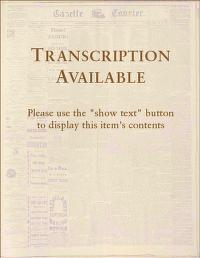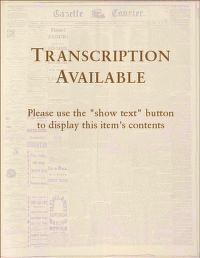|

Tide of Immigration article in The Gazette and Courier newspaper

"Communist Impudence" article in The Gazette and Courier newspaper

"Are We To Be Polanized?" article from the Greenfield Gazette and Courier newspaper
|
Summary and Objective
Students will understand that immigration and nativism have pervaded our nation's history with equal persistence, particularly in the years following the First World War. The lesson enables students to explore the Sacco and Vanzetti case, the Red Scare, immigration, nativism, and the nation's struggle to balance civil liberties and national security.
Teaching Plan
Step 1.
For homework, students will read about the Sacco and Vanzetti case in their textbook as well as "The Sacco-Vanzetti Case: An Account" by Douglas Linder. Students will complete a history frame or story map by providing the title of the event, key players, the problem or goal, where, when, key episodes or events, the resolution or outcome, and the theme or lesson. Linder's account is available at the Famous American Trials web site. See the link below.
Step 2.
Next students will study the chronology, maps, biographies of trial participants, and the summary of evidence provided at the Famous American Trials web site. In small groups, students will make a chart or graphic organizer showing evidence that can be used to show guilt or innocence.
Step 3.
In small groups, students will analyze the images and photographs of Sacco and Vanzetti found at the Famous American Trials site. In groups students will discuss the following: What impression do these images and photos give you of Sacco and Vanzetti? How might the prosecution and defense use these images differently in an attempt to persuade a jury? What aspects of the photos give the impressions?
Step 4.
Each group will be assigned two excerpts from the trial transcript located at the Famous Trials site. For each excerpt groups will complete a document analysis worksheet created by the National Archives. Groups will present their findings to the whole class.
Step 5.
Using the Famous American Trials site, students will read Sacco and Vanzetti's statements at sentencing. Students will highlight the contentions Sacco and Vanzetti put forth in support of their position that the state of Massachusetts has wrongly convicted them. Explain to the class that the case dragged on from 1920 to 1927 in a nativist atmosphere with the city, home of the immigrants with strange cultures, on one side and small towns and farms, dominated by native-born Protestant Americans, on the other. Conduct a class discussion: Are Sacco and Vanzetti's claims justified? How would urban and rural forces have used the case to bolster their own causes? What evidence did the prosecution have against Sacco and Vanzetti? What evidence did the defense present to controvert the prosecution's evidence? Which side presented a more convincing case? Why does Vanzetti discuss his family background? What are Vanzetti's reasons for not going into business? In saying that he has eschewed "what are considered the commodity and the glories of life" Vanzetti suggests that he disagrees with these values. What might he have identified as the "glories of life?" Explain. How is Vanzetti's immigrant background significant in this text? If you were one of the jurors in the original trial and were present to hear Vanzetti deliver this statement at his sentencing in 1927, how would you respond? Conduct a class discussion focusing on the question: Should Sacco and Vanzetti have been found guilty in court?
Step 6.
To make a local connection, students will read the "Are We To Be Polanized," "Tide of Immigration" and "Communist Impudence" articles from The Gazette and Courier newspaper. Students should maintain a list of all of the adjectives of bias. The class will discuss local reactions to the Sacco and Vanzetti case as well as the "new immigrants." The class will discuss the following: What perceived characteristics and stereotypical notions made "new immigrants" seem threatening to "native-born" Americans? What political currents led the prosecutor to bring Sacco and Vanzetti to trial? How much were Judge Thayer, District Attorney Katzmann, and the men in the jury box representative of Massachusetts or of American society in general? Of just what crime did the jury actually convict the defendants? What profile did Sacco and Vanzetti fit? What forms of discrimination did they face? What factors accounted for the conviction of Sacco and Vanzetti where legitimate evidence was deeply lacking? What "mounting body of evidence seemed to indicate that [Sacco and Vanzetti] were innocent"? Answer the question posed by a law professor: "Why all the fuss over a couple of 'wops'?" Judge Webster Thayer said of Vanzetti: "This man, although he may not actually have committed the crime ... is ... the enemy of our existing institutions.... The defendant's ideals are cognate with crime." Evaluate this statement. Did Sacco and Vanzetti receive a fair trial? How should our society balance civil liberties with national security?
Step 7.
Next have each group select a political cartoon dealing with the Sacco and Vanzetti case to analyze. The cartoons are available at the Michigan State University site listed below. Each group will complete a cartoon analysis worksheet created by the National Archives.
Step 8.
To close the lesson, each group will write a newspaper editorial and design a political cartoon arguing whether or not Sacco and Vanzetti received a fair trial.
|




